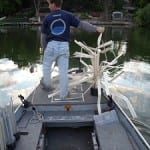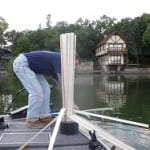NAVAJO DAM – A $300,000 fish habitat improvement project is scheduled to begin Oct. 10 on the trophy trout waters of the San Juan River below Navajo Dam.
The project is designed to enhance fishing opportunities in two ways: by reducing silt deposits from flash-flood events, and by creating deeper pools for fish during periods of low flow from Navajo Dam. The estimated completion date is Jan. 8.
“We’re excited that we can respond to anglers’ requests and move forward with this project that will make the world-class fishing on the San Juan River even better,” said Jim McClintic, chairman of the State Game Commission.
See the dozens of unique artificial fish habitat models, fish attractors and fish cover used at fishiding.com, the industry leader and only science based, man made and artificial fish habitat, proven to provide all fish with cover they prefer to prosper.
The project contractor, AUI Inc. of Albuquerque, was expected to be on site Oct. 10. The project will include:
- Sediment removal and control at the mouth of Rex Smith Wash, an arroyo that empties into the Kiddie Hole, a fishing spot just above popular Texas Hole. Flash-flood events carry silt into the river at that point, damaging trout habitat there and downstream. The project will include building a sediment retention pond that will slow the water flow during floods, catch sediment and redirect clean water back into the river. Silt in the retention pond will be removed periodically.
- Habitat improvement work in “The Braids,” a section of the river above Texas Hole and the Kiddie Hole where water levels drop to very low levels during times of low flow from the dam. It will include digging holes in the sandstone riverbed to create deeper pools for trout. Structure such as large cottonwood trunks, big rocks and faux beaver dams will be strategically placed to redirect flows into the new pools.
Mike Sloane, chief of fisheries for the Department of Game and Fish, said anglers should not be inconvenienced at the Kiddie Hole during the project except for some noise and truck traffic. Work in “The Braids,” however, will require the area to be closed to fishing for about 30 days in November and early December.
State funding will pay for most of the project, with some additional federal funds. The project was approved by the U.S. Bureau of Reclamation, which controls the river operations; the State Parks Division, and the U.S. Fish and Wildlife Service.
PUBLIC MEETINGS WILL ADDRESS PIKE IN EAGLE NEST LAKE
EAGLE NEST – The Department of Game and Fish will conduct meetings this month to inform the public and gather input about a proposal to change fishing rules at Eagle Nest Lake to address a threat to the lake’s trout fishery by the illegal introduction of northern pike.
The pikes’ presence in the lake was discovered in November 2010 when a 13-year-old angler from Espanola reported catching one there. Since then, many more have been caught in the lake by anglers and Department staff. Some of the pike have grown to 30 inches or more, said Eric Frey, fisheries biologist for the Northeast Area.
Northern pike feed primarily on large quantities of fish such as rainbow trout fingerlings and kokanee salmon fry. The Department stocks about 600,000 fingerling rainbow trout and about 200,000 kokanee salmon fry in the lake annually to maintain the lake as one of the state’s top coldwater fisheries. Predatory northern pike present a significant threat to that fishery, Frey said.
To help manage the pike population in the lake, the Department is recommending changing the daily bag limit to allow unlimited take and possession of northern pike, and to require Eagle Nest Lake anglers to keep all northern pike they catch.
The meetings:
- Oct. 11, 5 to 6 p.m.: Eagle Nest Lake State Park visitors center, No. 42 Marina Way, Eagle Nest.
- Oct. 12, 5 to 6 p.m.: Department of Game and Fish Northeast Area office, 215 York Canyon Road, Raton.
More information about the proposal can be found on the Department website, www.wildlife.state.nm.us under “Proposals for Public Comment,” or by contacting Eric Frey at (575) 445-2311 or eric.frey@state.nm.us.

.JPG)

